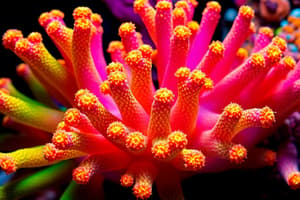Podcast
Questions and Answers
What is the primary function of choanocytes in sponges?
What is the primary function of choanocytes in sponges?
- To form the external lining of the sponge
- To filter water through their collar (correct)
- To provide structural support
- To produce nutrients for the sponge
Which type of cell is known for moving through the mesohyl and is totipotent?
Which type of cell is known for moving through the mesohyl and is totipotent?
- Choanocytes
- Archeocytes (correct)
- Pinacocytes
- Sclerocytes
Which secretory cells are responsible for producing mineral spicules?
Which secretory cells are responsible for producing mineral spicules?
- Choanocytes
- Sclerocytes (correct)
- Spongocytes
- Collencytes
What is the main role of pinacocytes in sponges?
What is the main role of pinacocytes in sponges?
Which cell type is primarily involved in forming channels for water flow in some sponges?
Which cell type is primarily involved in forming channels for water flow in some sponges?
What do spongocytes primarily produce in sponges?
What do spongocytes primarily produce in sponges?
Which cell type gives rise to all other cell types in a sponge?
Which cell type gives rise to all other cell types in a sponge?
What structural role do collagen spicules play in sponges?
What structural role do collagen spicules play in sponges?
What type of cells provide a filtering mechanism by pulling water through?
What type of cells provide a filtering mechanism by pulling water through?
In what cellular arrangement do porocytes exist within the sponge structure?
In what cellular arrangement do porocytes exist within the sponge structure?
Which of the following statements accurately describes autotrophs?
Which of the following statements accurately describes autotrophs?
What distinguishes osmotrophs from phagotrophs?
What distinguishes osmotrophs from phagotrophs?
Euglena viridis is capable of changing its nutritional mode. What condition triggers this change?
Euglena viridis is capable of changing its nutritional mode. What condition triggers this change?
During classic amoeboid phagocytosis, what is formed when the plasma membrane encloses a food particle?
During classic amoeboid phagocytosis, what is formed when the plasma membrane encloses a food particle?
What role does the Golgi body play in the feeding process of amoeboid forms?
What role does the Golgi body play in the feeding process of amoeboid forms?
What mechanism do Didinium use to capture its prey?
What mechanism do Didinium use to capture its prey?
How does the structure of Stentor contribute to its feeding mechanism?
How does the structure of Stentor contribute to its feeding mechanism?
What type of nutrition involves the ingestion of solid particles?
What type of nutrition involves the ingestion of solid particles?
Which type of nutrition is characterized by the absorption of soluble food?
Which type of nutrition is characterized by the absorption of soluble food?
What function does the lysosome perform during digestion in unicellular eukaryotes?
What function does the lysosome perform during digestion in unicellular eukaryotes?
What mechanism do suctorians use to obtain food?
What mechanism do suctorians use to obtain food?
Which organelle is responsible for osmoregulation in freshwater unicellular eukaryotes?
Which organelle is responsible for osmoregulation in freshwater unicellular eukaryotes?
What is the primary active transport mechanism identified in osmoregulation?
What is the primary active transport mechanism identified in osmoregulation?
During exocytosis, what occurs to eliminate undigested material?
During exocytosis, what occurs to eliminate undigested material?
In the context of osmoregulation, how does freshwater differ from the internal environment of unicellular eukaryotes?
In the context of osmoregulation, how does freshwater differ from the internal environment of unicellular eukaryotes?
What is a characteristic of the cytoproct?
What is a characteristic of the cytoproct?
How does environmental size impact the filling and expulsion rates of contractile vacuoles?
How does environmental size impact the filling and expulsion rates of contractile vacuoles?
What type of feeding mechanism do sponges practice?
What type of feeding mechanism do sponges practice?
What role does cytoplasmic carbonic anhydrase play in osmoregulation?
What role does cytoplasmic carbonic anhydrase play in osmoregulation?
Which of the following statements about metabolic waste diffusion is correct?
Which of the following statements about metabolic waste diffusion is correct?
Flashcards are hidden until you start studying
Study Notes
Introduction
- Sessile and multicellular animals without organs
- Functionally distinct cell types
- Filter feeders
- Water is pumped through the body via a system of canals
- Food particles are collected from the water
Cell Types
- Choanocytes
- Ovoid cells lining the canal system and chambers
- Have a collar forming a filtering device at the exposed end
- Flagella motion pulls water through the filter
- Embedded end in the mesohyl
- Archeocytes
- Amoeboid cells moving through the gelatinous matrix (mesohyl) within the sponge
- Receive food particles from choanocytes
- Digest food particles
- Totipotent (can differentiate into all other cell types in sponge)
- Secretory Cells
- Produce spicules
- Mineral (calcium)
- Protein (collagen, spongin)
- 3 subtypes
- Sclerocytes: produce mineral spicules
- Spongocytes: produce spongin spicules
- Collencytes: produce collagen spicules
- Produce spicules
- Pinacocytes
- Form the pinacoderm, a protective lining facing the external environment
- Also line some internal canals where choanocytes are not present
- Porocytes
- Found only in some sponges (Asconoid)
- Form channels in the pinacoderm through which water flows into the sponge (ostia)
General Arrangement of Cell Types
- Porocytes make up the ostia
- Pinacocytes form the pinacoderm, which is the outer layer of cells
- Archeocytes are found in the mesohyl, which is the gelatinous matrix within the sponge
- Sclerocytes are found in the mesohyl and produce spicules
- Choanocytes make up the choanoderm, which lines the internal canals of the sponge
Studying That Suits You
Use AI to generate personalized quizzes and flashcards to suit your learning preferences.




